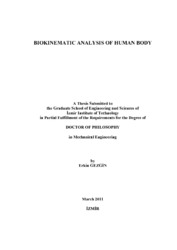Please use this identifier to cite or link to this item:
https://hdl.handle.net/11147/2892Full metadata record
| DC Field | Value | Language |
|---|---|---|
| dc.contributor.advisor | Alizade, Rasim | en |
| dc.contributor.author | Gezgin, Erkin | - |
| dc.date.accessioned | 2014-07-22T13:48:33Z | - |
| dc.date.available | 2014-07-22T13:48:33Z | - |
| dc.date.issued | 2011 | en |
| dc.identifier.uri | http://hdl.handle.net/11147/2892 | - |
| dc.description | Thesis (Doctoral)--Izmir Institute of Technology, Mechanical Engineering, Izmir, 2011 | en |
| dc.description | Includes bibliographical references (leaves: 118-123) | en |
| dc.description | Text in English; Abstract: Turkish and English | en |
| dc.description | xiii, 123 leaves | en |
| dc.description.abstract | This thesis concentrates on the development of rigid body geometries by using method of intersections, where simple geometric shapes representing revolute (R) and prismatic (P) joint motions are intersected by means of desired space or subspace requirements to create specific rigid body geometries in predefined octahedral fixed frame. Using the methodical approach, space and subspace motions are clearly visualized by the help of resulting geometrical entities that have physical constraints with respect to the fixed working volume. Also, this work focuses on one of the main areas of the fundamental mechanism and machine science, which is the structural synthesis of robot manipulators by inserting recurrent screws into the theory. After the transformation unit screw equations are presented, physical representations and kinematic representations of kinematic pairs with recurrent screws are given and the new universal mobility formulations for mechanisms and manipulators are introduced. Moreover the study deals with the synthesis of mechanisms by using quaternion and dual quaternion algebra to derive the objective function. Three different methods as interpolation approximation, least squares approximation and Chebyshev approximation is introduced in the function generation synthesis procedures of spherical four bar mechanism in six precision points. Separate examples are given for each section and the results are tabulated. Comparisons between the methods are also given. As an application part of the thesis, the most important elements of the human body and skeletal system is investigated by means of their kinematic structures and degrees of freedom. At the end of each section, an example is given as a mechanism or manipulator that can represent the behavior of the related element in the human body. | en |
| dc.language.iso | en | en_US |
| dc.publisher | Izmir Institute of Technology | en |
| dc.rights | info:eu-repo/semantics/openAccess | en_US |
| dc.subject.lcsh | Kinematics | en |
| dc.subject.lcsh | Machinery, Kinematics of | en |
| dc.subject.lcsh | Human mechanics | en |
| dc.subject.lcsh | Robots--Kinematics | en |
| dc.title | Biokinematic analysis of human body | en_US |
| dc.type | Doctoral Thesis | en_US |
| dc.department | Thesis (Doctoral)--İzmir Institute of Technology, Mechanical Engineering | en_US |
| dc.relation.publicationcategory | Tez | en_US |
| item.fulltext | With Fulltext | - |
| item.grantfulltext | open | - |
| item.languageiso639-1 | en | - |
| item.openairecristype | http://purl.org/coar/resource_type/c_18cf | - |
| item.cerifentitytype | Publications | - |
| item.openairetype | Doctoral Thesis | - |
| Appears in Collections: | Phd Degree / Doktora | |
Files in This Item:
| File | Description | Size | Format | |
|---|---|---|---|---|
| T000917.pdf | DoctoralThesis | 8.16 MB | Adobe PDF |  View/Open |
CORE Recommender
Page view(s)
262
checked on Nov 18, 2024
Download(s)
120
checked on Nov 18, 2024
Google ScholarTM
Check
Items in GCRIS Repository are protected by copyright, with all rights reserved, unless otherwise indicated.